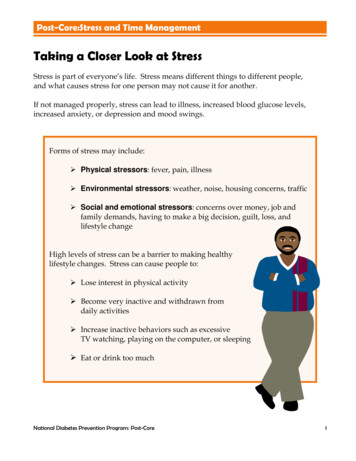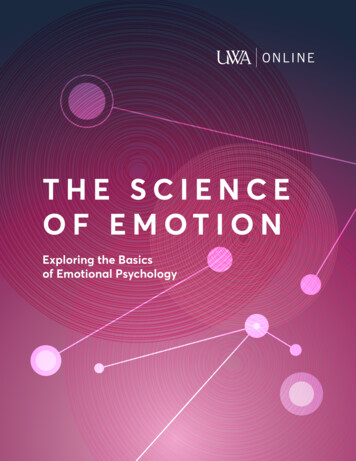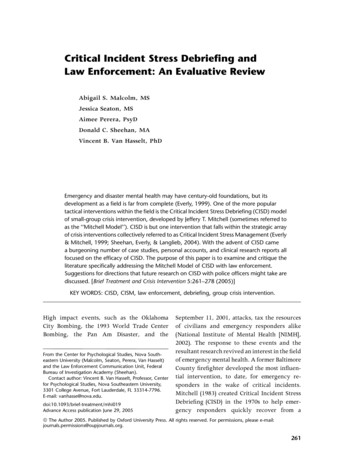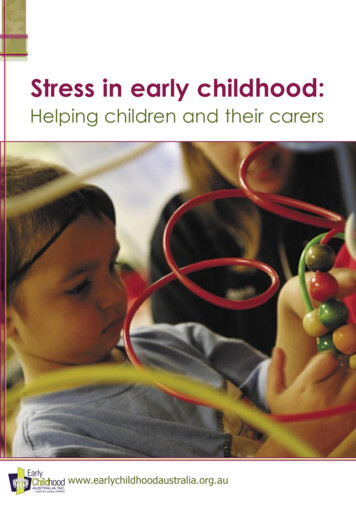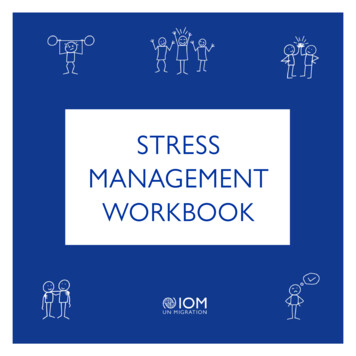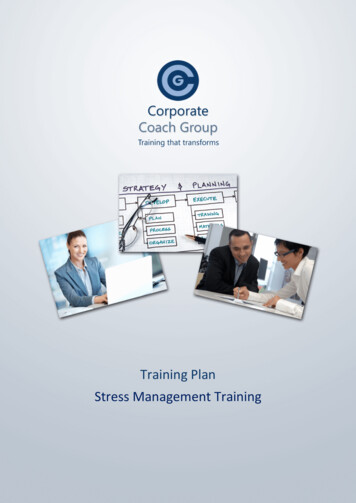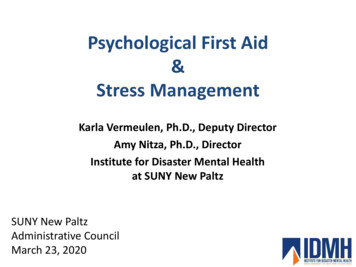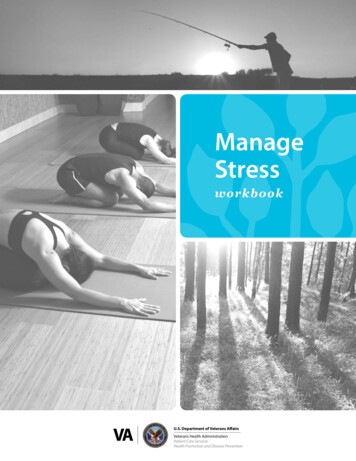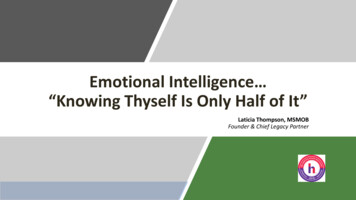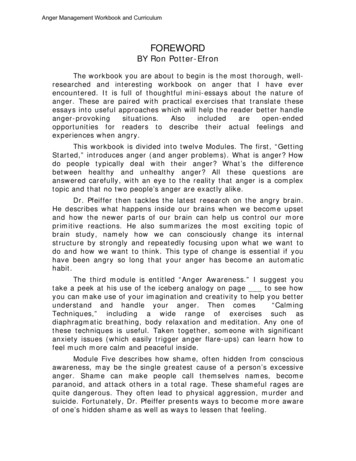
Transcription
Emotional Stress,Positive Emotions andPsychophysiologicalCoherenceRollin McCraty, Ph.D.Dana TomasinoHeartMath Research CenterInstitute of HeartMath
Emotional Stress, Positive Emotions,and Psychophysiological CoherenceRollin McCraty, Ph.D.Dana TomasinoHeartMath Research CenterInstitute of HeartMathMcCraty, R.M., 2006. Emotional Stress, PositiveEmotions, and Psychophysiological Coherence. In Stressin Health and Disease. Bengt B. Arnetz, Rolf Ekman,editors. Wiley-VCH, Weinheim.copyright 2006 Institute of HeartMath
Emotional Stress, Positive Emotions, and Psychophysiological CoherenceAddress for correspondence:Rollin McCraty, Ph.D.HeartMath Research CenterInstitute of HeartMath14700 West Park AvenueBoulder Creek, CaliforniaUSAEmail: rollin@heartmath.orgPhone: (831) 338-8727Fax: (831) 338-11822
Emotional Stress, Positive Emotions, and Psychophysiological CoherenceChris, a 45-year-old business executive, had a family history of heart disease, and wasfeeling extremely stressed, fatigued, and generally in poor emotional health. A 24-hour heart ratevariability analysis1 revealed abnormally depressed activity in both branches of his autonomicnervous system, suggesting autonomic exhaustion ensuing from maladaptation to high stress levels.His heart rate variability was far lower then would be expected for his age, and was below theclinical cut-off level for significantly increased risk of sudden cardiac death. In addition, Chris’saverage heart rate was abnormally high at 102 beats per minute, and his heart rate did not dropat night as it should.Upon reviewing these results, his physician concluded that it was imperative that Christake measures to reduce his stress. He recommended that Chris begin practicing a set of emotionalrestructuring techniques that had been developed by the Institute of HeartMath . These positiveemotion-focused techniques help individuals learn to self-generate and sustain a beneficialfunctional mode known as psychophysiological coherence, characterized by increased emotionalstability and by increased synchronization and harmony in the functioning of physiologicalsystems.Concerned about his deteriorating health, Chris complied with his physician’srecommendation. Each morning during his daily train commute to work, he practiced the HeartLock-In technique, and he would use the Freeze-Frame technique in situations when he felt hisstress levels rise.2At first Chris was not aware of the transformation that was occurring. His wife was the firstto notice the change and to remark about how differently he was behaving and how much better helooked. Then his co-workers, staff, and other friends began to comment on how much less stressedhe appeared in responding to situations at work and how much more poise and emotional balancehe had. A second autonomic nervous system assessment, performed six weeks after the initial one,showed that Chris’s average heart rate had decreased to 85 beats per minute and it now lowered atnight, as it should. Significant increases were also apparent in his heart rate variability, which hadmore than doubled! These results surprised Chris’ physician, as 24-hour heart rate variability isThe analysis of heart rate variability (HRV), a measure of the naturally occurring beat-to-beat changes in heart rate,provides an indicator of neurocardiac fitness and autonomic nervous system function. Abnormally low 24-hour HRVis predictive of increased risk of heart disease and premature mortality. HRV is also highly reflective of stress andemotions.1The Heart Lock-In tool is an emotional restructuring technique, generally practiced for 5 to 15 minutes, that helpsbuild the capacity to sustain the psychophysiological coherence mode for extended periods of time. The FreezeFrame technique is a one-minute positive emotion refocusing exercise used in the moment that stress is experiencedto change perception and modify the psychophysiological stress response. The steps of these techniques arepresented later in this chapter.23
Emotional Stress, Positive Emotions, and Psychophysiological Coherencetypically very stable from week to week, and it is generally quite difficult to recover from autonomicnervous system depletion, usually requiring much longer than six weeks.In reflecting on his experience, Chris started to see how profoundly his health and his lifehad been transformed. He was getting along with his family, colleagues, and staff better than hecould remember ever having enjoyed before, and he felt much more clearheaded and in commandof his life. His life seemed more harmonious, and the difficulties that came up at work and in hispersonal relationships no longer created the same level of distress; he now found himself ableapproach them more smoothly and proactively, and often with a broadened perspective.The true story of Chris’ transformation is not an isolated example, but rather is only one ofmany similar case histories illustrating the profound transformations that have taken place whenpeople have learned to self-manage their stress using these heart-based, positive emotion-focusedtools. In this chapter, I describe two core tools of the HeartMath system, the Freeze-Frame and HeartLock-In techniques, and then explore the scientific basis of their effectiveness. This discussion isbuilt upon a conceptual framework that emphasizes the emotional component of the experienceof stress and the proposition that truly transforming stress requires intervention at the emotionallevel. To understand how stress is generated and processed in the brain and body, I present a modelof emotion, based on Pribram’s theory, in which the brain functions as a complex pattern-matchingsystem. From this perspective, it is shown that the heart is a key component of the emotionalsystem, with the patterns of its extensive inputs to the brain making an important contribution toemotional experience. I also provide an overview of the Institute of HeartMath’s research on thephysiological correlates of positive emotions, which has led to the characterization of a distinctivemode of psychophysiological functioning known as psychophysiological coherence. Through theuse of tools and technologies that foster positive emotions and psychophysiological coherence,individuals can effectively initiate a repatterning process, whereby habitual emotional patternsunderlying stress are replaced with new, healthier patterns that establish increased emotionalstability, mental acuity, and physiological efficiency as a new familiar baseline or norm.The Emotional Basis of StressThe term “stress” has become one of the most widely exercised words in everydayvernacular. People describe themselves as “stressed” when stuck in traffic and also whenexperiencing the dissolution of a long-term relationship. Preparing for an examination, havingdifficulty communicating with a coworker, dealing with serious illness in the family, and adjustingto new living or working conditions can all be “stressful.” But what is the common thread that4
Emotional Stress, Positive Emotions, and Psychophysiological Coherenceunites these diverse experiences, making them worthy of a common descriptor? What defines theessence of the experience of “stress”?A widely accepted model of stress involves the perception and appraisal of a stimulus asthreatening, and the consequent activation of set of physiological reactions characterized as the“stress response.” Thus, stress research has traditionally been oriented towards studies examiningthe cognitive processes that influence the perception of stress (a cognitive perspective) or thebody’s response to stress (a physiological perspective). Surprisingly, however, comparativelylittle attention has been given to the role of the emotional system in the stress process. From apsychophysiological perspective, emotions are central to the experience of stress; indeed, it is theemotions activated in response to perceiving a stimulus as threatening—threatening—feelings such as anxiety,irritation, frustration, lack of control, or hopelessness—that are truly what we are experiencingwhen we describe ourselves as “stressed.” All of the above examples of “stressors”—whetherminor inconveniences or a major life changes—are experienced as “stressful” to the extent thatthey trigger emotions such as these.While mental processes clearly play a role in stress, it is most often unmanaged emotionsthat provide fuel for their sustenance. It is well recognized that thoughts carrying an “emotionalcharge” are those that tend to perpetuate in consciousness. It is also emotions—more than thoughtsalone—that activate the physiological changes comprising the “stress response.” Our own researchhas clearly shown that a purely mental activity, such as cognitively recalling a past situation thatprovoked anger, does not produce nearly as profound an impact on physiological processes asactually engaging the emotion associated with that memory—actually reexperiencing the feelingof anger. It is the emotion that activates the autonomic nervous system and hypothalamic-pituitaryadrenal axis, leading to changes in the activity and function of the body’s systems and organs.Thus, many of the deleterious effects of stress on the brain and body are in fact physiologicalrepercussions of negative emotions.In essence, stress is conceptualized here as emotional unease—the experience of whichranges from low-grade feelings of emotional unrest to intense emotional turmoil. It is furthercontended that stress arises not only in direct response to external situations or events, but also, to alarge extent, involves the ongoing internal emotional processes and attitudes individuals perpetuateeven in the absence of any identifiable extrinsic stimulus. Recurring feelings of agitation, worry,and anxiety; anger, judgmentalness, and resentment; discontentment and unhappiness; insecurity5
Emotional Stress, Positive Emotions, and Psychophysiological Coherenceand self-doubt often consume a large part of our emotional energy and disrupt our feeling worldeven as we are engaged in the flow of everyday life and not necessarily confronted with a specific,current “stressor.” Indeed, many people do not realize the extent to which these internalized habitualemotional patterns dominate their internal landscape, diluting and limiting positive emotionalexperience, and eventually becoming so familiar that “stress” essentially becomes a defining partof their sense of self-identity (1, 2).Breaking the Stress Cycle: The Power of Positive EmotionsAlthough most stress has an emotional source, it is interesting to observe that most of thewidely used stress management interventions do not directly focus on emotions. For example,relaxation has long been seen as the ultimate remedy for stress; many individuals believe that ifthey could just learn to relax then they would be healthier and happier. Relaxation is a helpfuland beneficial process in that it temporarily draws attention away from distressing feelings andreduces physiological arousal, thereby promoting regeneration of the body. However, relaxationtechniques generally do not address the unmanaged emotions that are the root cause of stress—nordo they seek to transform the deeper, recurring emotional patterns that give rise to stress-producingfeelings. Without these more fundamental changes at the emotional level, any relief from stressthat is experienced is likely to be short-lived.Other techniques commonly used to manage stress are derived from cognitive-behavioralpsychotherapy. The cognitive-behavioral model operates from the theory that maladaptive thoughtsdrive unhealthy behaviors and that these thoughts should therefore be the focus of therapeuticintervention. Cognitive-Behavioral Therapy by definition excludes emotions as a primary focus forattention, and although emotions may be explored, they are seen as a consequence of maladaptivethoughts. According to the cognitive model, all emotions follow a cognitive assessment of sensoryinput, which then leads to a behavioral response. The basic theoretical framework on whichcognitive-behavioral methods are based, thus, is that if emotions always follow thought, then bychanging one’s thoughts, one can gain control over one’s emotions.In the last decade, however, research in the neurosciences has made it quite clear thatemotional processes operate at a much higher speed than thoughts, frequently bypassing the mind’slinear reasoning process entirely (3). Further, although emotions can be induced by thoughts, theymay also arise from unconscious associations triggered by external or internal events. In otherwords, not all emotions follow thoughts; emotions often occur independently of the cognitive6
Emotional Stress, Positive Emotions, and Psychophysiological Coherencesystem and, moreover, can significantly bias or color the cognitive process and its output or decision(3, 4). For this reason, a therapeutic focus on thought processes alone may often fail to identifythe fundamental cause of an emotional disturbance and thus to resolve it. In some cases, try as onemight to rectify one’s thinking, one can fall short of achieving emotional relief simply becausethe underlying maladaptive emotional pattern may be driven largely by unconscious triggers thatoperate independently of the intellect.Further insight is gained from current research in neuroscience, which is confirming thatemotion and cognition can best be thought of as separate but interacting functions and systems,which communicate via bidirectional neural connections between the neocortex and emotionalcenters such as the amygdala. These connections allow emotion-related input to modulate corticalactivity and cognitive input from the cortex to modulate emotional processing. However, researchindicates that within the brain, neural connections from the emotional system to the cognitive systemare stronger and more numerous than those flowing from the cognitive to the emotional system (3)(Figure 1). This provides a physiological basis for the common experience that emotional arousalcan readily dominate the mental landscape, yet it is usually far more difficult to willfully “turnoff” strong emotions through thought alone. Likewise, it is generally one’s emotional experience,rather than solely cognitive activity, that is the strongest motivator of attitudes, decisions, andbehavior.Figure 1. Simplified representation illustrating the asymmetry in the neural connectionsbetween the emotional and cognitive systems in the brain. The neural connections that transmitinformation from the emotional centers to the cognitive centers in the brain are stronger and morenumerous than those that convey information from the cognitive to the emotional centers. Thisaccounts for the powerful influence of input from the emotional system on virtually all stages ofcognitive processing involved in functions such as attention, perception, and memory, as well ason higher-order thought processes. Conversely, the comparatively limited influence of input fromthe cognitive system on emotional processing helps to explain why it is so difficult to modulate ouremotions through thought alone.7
Emotional Stress, Positive Emotions, and Psychophysiological CoherenceThis is why strategies that encourage “positive thinking”—without also engaging positivefeelings—may frequently provide only temporary, if any, relief from emotional distress. While theindividual may make a conceptual shift (which is important), the fundamental source of stress anddriver of unhealthy behavior—the underlying maladaptive emotional pattern—remains largelyintact. This understanding of how the cognitive and emotional systems interact has significantimplications for emotion regulation interventions: it suggests that intervening at the level of theemotional system itself is a more direct, efficient, and powerful way to override and transformthe maladaptive patterns underlying unhealthy psychological, behavioral, and physiological stressresponses.More specifically, it is proposed that the activation of positive emotions plays a critical role inbreaking the stress cycle by effectively transforming stress at its source. The transformative powerof positive emotions is far from a new concept, having been noted for centuries by religious scholars,artists, scientists, medical practitioners, and lay authors alike. However, scientific exploration ofthese experiences has been for the most part lacking. Overshadowed by the prevailing pathologyoriented paradigm of modern psychology, positive emotions have only recently been reexaminedin a scientific light (5). Hardly surprisingly, a growing body of such research is now beginning toprovide objective evidence of the centrality of positive emotions to optimal functioning in nearlyall spheres of human experience. Positive emotions have been demonstrated to improve healthand increase longevity (6, 7). They have also been shown to affect the way we think and addresschallenges—increasing cognitive flexibility, creativity, receptivity,and innovative problem solving.Positive emotions further shape our behavior, promoting helpfulness, generosity, and effectivecooperation. In short, it is suggested that positive emotions are critical to our effective adaptationto life’s challenges, and to our growth and development as human beings (1, 8, 9).Intriguingly, research is now beginning to reveal some of the underlying physiologicalprocesses that may help explain how positive emotions improve health, enhance cognitive function,and promote constructive behavior. As described in detail below, we have found that positiveemotions are associated with a specific physiological state characterized by increased systemwide coherence, which in turn is associated with improved physiological functioning, emotionalstability, and cognitive performance.Positive Emotion-Focused Tools and TechniquesThe recent Positive Psychology movement has emphasized the importance of encouragingnot only the reduction of negative emotions, but also the cultivation of positive emotions in8
Emotional Stress, Positive Emotions, and Psychophysiological Coherencedaily life. Yet, psychology has seen a notable scarcity of interventions that focus directly andsystematically on increasing positive emotional experiences. Recognizing this need many yearsago, Doc Childre, founder of the Institute of HeartMath, undertook the development of practical,heart-based positive emotion-focused tools and techniques, which are designed to facilitate theself-regulation of emotions (2, 10). Collectively known as the HeartMath system, these tools areintentionally designed as simple, easy-to-use interventions that can be adapted to virtually anyculture, setting, or age group. They are free of religious or cultural bias, and most people feel apositive emotional shift and experience a broadened perception the first time they use them.Briefly, these interventions combine a shift in the focus of attention to the area around theheart (where many people subjectively feel positive emotions) with the intentional self-inductionof a sincere positive emotional state, such as appreciation. We have found that appreciation is oneof the most concrete and easiest of the positive emotions for individuals to self-induce and sustainfor longer periods.Here I describe two of the core HeartMath tools, the Freeze-Frame and Heart Lock-Intechniques, which are the tools that were used in Chris’ case history that opened this chapter.Freeze-Frame: A Positive Emotion Refocusing TechniqueFreeze-Frame is a positive emotion refocusing exercise that enables individuals to intervenein the moment to greatly reduce or prevent the stress created from inappropriate or unproductiveemotional triggers and reactions. The technique’s name is derived from the concept that consciousperception works in a way that is analogous to watching a movie, in that each moment is perceivedas an individual perceptual frame. When a scene becomes stressful, it is possible and helpful tofreeze that perceptual frame and isolate it in time so that it can be observed from a more detachedand objective viewpoint—similar to putting a VCR on pause for the moment. We have found thatthe process of intentionally de-energizing and temporarily disengaging from distressing thoughtsand emotions can be greatly facilitated by shifting one’s attention to the physical area around theheart (center of the chest) and self-generating a sincere positive feeling, such as appreciation.This process prevents or interrupts the body’s normal stress response and also facilitates highercognitive faculties that are normally compromised during stress and negative emotional states. Thissharpens one’s discernment abilities, increases resourcefulness, and often facilitates a perceptualshift, which allows the original stressor to then be assessed and addressed from a broader, moreemotionally balanced perspective.9
Emotional Stress, Positive Emotions, and Psychophysiological CoherenceThe Freeze-Frame technique consists of five simple steps, which can be effectively appliedin real time in the midst of a stressful situation or day-to-day activities (e.g., while driving, sitting ina meeting, interacting with others, etc.). The tool can be used effectively in less than one minute.The Steps of Freeze-Frame:1. Take a time-out so that you can temporarily disengage from your thoughts and feelings,especially stressful ones.2. Shift your focus of attention to the area around your heart. Now feel your breath comingin through your heart and going out through your solar plexus.Practice breathing this way a few times to ease into the technique.3. Make a sincere effort to activate a positive feeling.Allow yourself to feel genuine appreciation or care for some person, some place, or somethingin your life.4. Ask yourself what would be an efficient, effective attitude or action that would balanceand destress your system.Your ability to think more clearly and objectively is enhanced based on the increased coherenceyou’ve created in steps 2 and 3. You can view the issue now from a broader, more balancedperspective. Ask yourself what you can do to help minimize future stress.5. Quietly sense any change in perception or feeling, and sustain it as long as you can.Heart perceptions are often subtle. They gently suggest effective solutions that would be bestfor you and all concerned.The key elements of the technique are: Shift (to the area of the heart), Activate (a positivefeeling), and Sense (what is the best perspective or attitude for this situation). In most trainingcontexts, individuals are first led through several exercises designed to aid them in identifying theirdeepest core values and the people, places, or events they truly appreciate and care about. Thishelps them with Step 3, where they are asked to self-generate a feeling of appreciation or otherpositive emotion, which is an important aspect of the technique’s effectiveness.An important way in which Freeze-Frame is distinguished from various other stressmanagement interventions is that it is designed to enable individuals to intercede in the momentthat stress is being experienced—rather than try to recuperate “after the fact.” The benefits of thiscannot be overstated. Using Freeze-Frame in the “heat of the moment” saves tremendous amounts10
Emotional Stress, Positive Emotions, and Psychophysiological Coherenceof energy that otherwise would have been drained and often prevents hours of emotionallyinduced wear and tear on the body and psyche. It can also reduce the time and energy spent dealingwith the consequences of impulsive decisions or emotionally charged reactions, such as regret,embarrassment, guilt, accidents, and damaged relationships.One of the long-term benefits to be gained from the practice of emotion refocusingtechniques such as Freeze-Frame is increased emotional awareness, a fundamental step in theprocess of improving emotional well-being. In addition to helping people modify their responsesto stressful events in the external environment, such techniques also help individuals identify andmodify more subtle internal stressors (i.e., persistent self-defeating and energy-depleting thoughtpatterns and feelings, such as anxiety, fear, hurt, resentment, judgmentalism, perfectionism, andprojections about the future). As individuals practice “freezing the frame” when feeling inneremotional unrest, they gain increased awareness of the habitual mental and emotional processesthat underlie their stress, and become more able to catch the onset of these feelings and patterns,thus diminishing their influence.Heart Lock-In: An Emotional Restructuring TechniqueHeart Lock-In is an emotional restructuring technique that is generally taught as a companion tool to Freeze-Frame. The Heart Lock-In technique focuses on building the capacity tosustain heartfelt positive emotions and their associated benefits for longer periods. This techniqueis generally practiced for five to fifteen minutes at a time, although longer sessions may be used aswell. If desired, practice of this technique may also be facilitated by music specifically created topromote emotional balance and augment the favorable psychological and physiological effects ofpositive affective states (11).The Steps of Heart Lock-In:1. Gently shift your attention to the area around your heart.2. Shift your breathing so that you are breathing in through the heart and out through thesolar plexus.3. Activate a genuine feeling of appreciation or care for someone or something in your life.4. Make a sincere effort to sustain feelings of appreciation or care while directing them toyourself and others.11
Emotional Stress, Positive Emotions, and Psychophysiological Coherence5. When you catch your mind wandering, gently focus your breathing back through the heartand solar plexus and reconnect with feelings of care or appreciation.After you’re finished, sincerely sustain your feelings of care and appreciation as long as you can.This will act as a cushion against recurring stress or anxiety.The key elements of the technique are: Focus (in the area of the heart), Appreciate, andSustain (positive feelings). In the midst of life’s perpetual activity, the Heart Lock-In offers asimple way to cultivate and amplify heartfelt positive feelings and their nourishing effects onthe body and psyche. This process is typically accompanied by feelings of deep peacefulness,harmony, and a sense of inner warmth, and is often an effective means to diffuse accumulatedstress and negative feelings. Also, in quieting the normal stream of mental dialogue through thisprocess, many report the spontaneous emergence of increased intuitive clarity and insight relativeto problems or troublesome issues.Studies conducted across diverse populations in laboratory, organizational, educational,and clinical settings have demonstrated that HeartMath positive emotion-focused techniques areeffective in producing both immediate and sustained reductions in stress, together with improvementsin many dimensions of psychosocial well-being. Moreover, these interventions have also beenshown to give rise to significant improvements in key health and performance-related measures.For a review of outcome studies, see (1, 11). Collectively, results indicate that such techniquesare easily learned and used, produce rapid improvements, have a high rate of compliance, and arereadily adaptable to a wide range of demographic groups.The Scientific Basis of the HeartMath TechniquesWe now turn to examining, from a psychophysiological perspective, the scientific basis ofthe positive emotion-focused tools described here. This discussion will lead us through a systemsmodel of how emotions are generated and processed, explain the important role of the heart in theemotional system, and describe the psychophysiological changes associated with the induction ofpositive emotional states.The Generation of Emotions: A Pattern-Matching ProcessRecent years have seen the emergence of a new understanding of how the brain functionsas well as of the brain-body dynamics involved in emotional processing. Rather than assemblingthoughts and feelings from bits of data like a digital computer, the brain is an analog processorthat relates whole concepts or patterns to one another and looks for similarities, differences, and12
Emotional Stress, Positive Emotions, and Psychophysiological Coherencerelationships between them. This new way of understanding brain processes has also challengedlong-held views of how emotions are generated. Psychologists once maintained that emotions werepurely mental expressions generated by the brain alone. We now know, instead, that emotions haveas much to do with the body as they do with the brain: thus, the emergence of emotional experienceresults from the ongoing interaction between the brain, the body, and the external environment.Our research findings support a systems model of emotion that includes the heart, brain, andthe nervous and hormonal systems as fundamental components of a dynamic, interactive networkthat underlies the emergence of emotional experience (12). This model is based on the theoryof emotion first proposed by Pribram (13), in which the brain functions as a complex patternidentification and matching system. In this model, past experience builds within us a set of familiarpatterns, which are instantiated in the neural architecture. Inputs to the brain from both the externaland internal environments contribute to the maintenance of these patterns via a feedback process.Within the body, the patterns of activity of many processes provide constant rhythmic inputswith which the brain becomes familiar. These include the heart’s rhythmic activity; digestive,respiratory, and hormonal rhythms; and activation patterns of muscular tension, particularly facialexpressions. These inputs are continuously monitored by the brain and help organize sensoryperceptio
The Freeze-Frame technique is a one-minute positive emotion refocusing exercise used in the moment that stress is experienced . In this chapter, I describe two core tools of the HeartMath system, the Freeze-Frame and Heart Lock-In techniques, and then explore the sc
